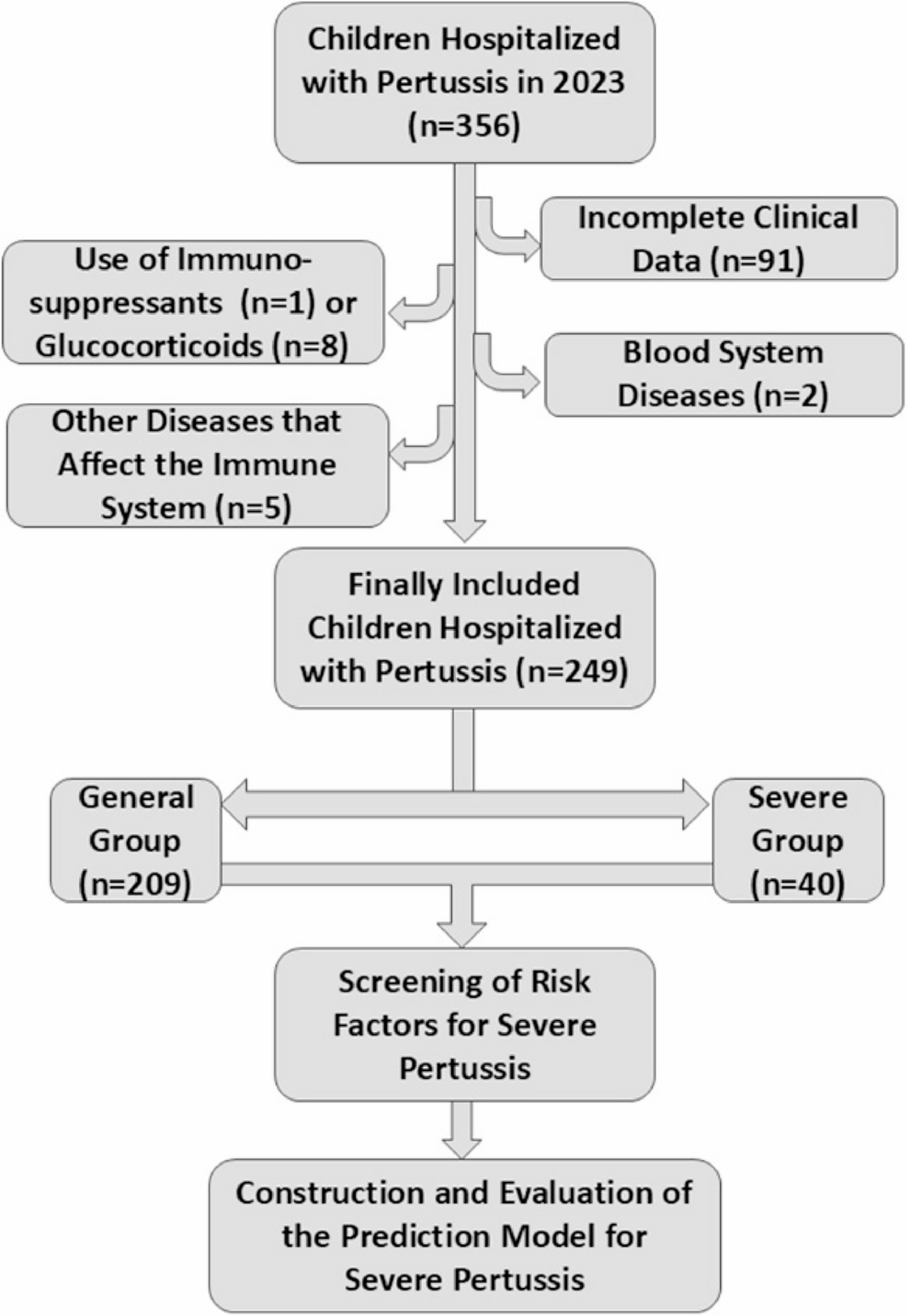The investigation of severe pertussis in children has become a major research focus both domestically and internationally, with a consensus that severe cases are predominantly concentrated among infants, especially those aged ≤ 3 months [17]. Our study also demonstrated a higher proportion of infants ≤ 3 months in the severe group, with statistically significant differences. In terms of geographical distribution, 55% of children with severe pertussis in our study resided in rural areas, which is significantly higher than in the general group. This is likely related to lower vaccination rates, insufficient medical resources, and difficulties in controlling transmission in rural areas. A study from South Africa found that pertussis incidence in rural communities (0.21 per 100 person-weeks) was 2.3 times higher than in urban areas, which matches our findings [18].
Prematurity is a well-known predictor of severe pertussis and pertussis-related death in children [19, 20]. Our study found that preterm infants were more common in the severe group compared to the general group, and this factor had the highest predictive value in the Nomogram model. This is primarily due to the underdeveloped respiratory and immune systems of preterm infants. Specifically, the insufficient secretion of IFN-γ by CD4⁺ T cells and impaired antigen-presenting function of dendritic cells (DCs) in preterm infants further increase their susceptibility and severity of pertussis. A study on maternal pertussis vaccination and neonatal pertussis antibody concentrations showed that vaccination with Tdap during the third trimester of pregnancy was associated with higher neonatal pertussis toxin antibody concentrations compared to unvaccinated mothers [21]. In China, it is recommended that pregnant women receive pertussis vaccination between 26 and 34 weeks of gestation. Therefore, preterm infants who are delivered early may have lower levels of maternal IgG antibodies transferred through the placenta compared to full-term infants, thus increasing their susceptibility and severity of pertussis. Further research is anticipated in this area.
Pertussis vaccines can be categorized into whole-cell pertussis vaccine (wP) and acellular pertussis vaccine (aP). Currently, there is a significant variation in pertussis vaccination strategies across different countries. Since January 1, 2025, China has implemented a new immunization schedule nationwide, which includes administering a dose of acellular pertussis vaccine at 2, 4, 6, 18 months, and 6 years of age [22]. Timely and complete vaccination against pertussis remains the most specific and effective measure to reduce the incidence of severe pertussis in children. A single-center retrospective study of 967 pertussis cases over an 8-year period in Beijing, China, showed that not receiving pertussis vaccination was an independent risk factor for severe pertussis (OR = 0.229, 95% CI: 0.071–0.736, P = 0.013) [23]. Our study also confirmed that incomplete pertussis vaccination is an independent risk factor for severe pertussis with good predictive value in the prediction model.
Leukocytosis is a characteristic manifestation of pertussis, primarily caused by pertussis toxin (PT) [24]. A significant increase in white blood cell (WBC) count is associated with pulmonary hypertension, and autopsy results have shown leukemic thrombi in the pulmonary vessels of children with pertussis [25]. In our study, one patient had a WBC count as high as 117 × 10⁹/L and had a poor prognosis. High WBC counts are closely related to rapid disease progression and increased mortality risk. However, there is variation among studies in the definition of leukocytosis [26,27,28]. In this study, a WBC count > 30 × 10⁹/L was used as the cutoff value for predicting severe pertussis, and it was identified as an independent risk factor for severe pertussis in children.
In our study, the serum levels of IgA, IgG, and complement C3 were significantly lower in the severe group compared to the mild group, suggesting that children with severe pertussis may have impaired humoral immune function. Kurvers et al. reported two monozygotic twins with congenital C3 deficiency who developed severe pertussis, further highlighting the need to be vigilant for severe pertussis in children with significantly weakened humoral immunity [29].
Lymphocyte subsets, as important indicators of immune response, play an indispensable role in the occurrence and development of severe pertussis. The commonly tested lymphocyte subsets include T lymphocytes (CD3⁺), B cells (CD19⁺), and NK cells (CD16/56⁺). T cells are further divided into two subsets: helper T cells (CD4⁺) and cytotoxic T cells (CD8⁺) [30]. Our study found that the absolute values of CD3⁺, CD4⁺, CD8⁺, CD19⁺, and CD16/56⁺ cells were significantly higher in the severe group than in the mild group, and the counts of CD3⁺, CD4⁺, and CD19⁺ cells were identified as risk factors for severe pertussis. Currently, there is considerable attention on Th1/Th17 cells in the immune response to pertussis. Th1/Th17 cells, important subsets of CD4⁺ cells, induce Th1 cell polarization and IL-23 expression upon exposure to Bordetella pertussis, leading to the proliferation of Th17 cells. The secretion of IL-17 by these cells is involved in the pathogenesis of prolonged spasmodic cough and severe pertussis [12, 31]. In our study, the increased CD4⁺ cell count in the severe group may suggest an elevated presence of Th17 cells, although this remains speculative and warrants further investigation. It is important to note that our findings are associative in nature, and additional research is needed to establish a direct link between Th17 cells and severe pertussis in humans. Furthermore, CD16/56⁺ cells are core cells of the innate immune system, and their deficiency can lead to severe disseminated pertussis infection [32]. An animal study by Ashley E et al. showed that neonatal mice infected with Bordetella pertussis had immature NK cell phenotypes in their lungs, with no upregulation of the IFN-γ-inducing cytokine IL-12p70, resulting in insufficient IFN-γ release and subsequent widespread bacterial dissemination [33]. This suggests that infant pertussis may resemble severe pertussis in NK cell-deficient neonatal mice. Although the number of CD16/56⁺ cells was significantly higher in the severe group in our study, their function may be impaired, which also requires further investigation. Additionally, our study found no significant differences in the ratios of CD3⁺, CD4⁺, CD8⁺, CD19⁺, and CD4⁺/CD8⁺ between the two groups, indicating that immune imbalance may be more dependent on absolute lymphocyte counts rather than proportions. While our study suggests a correlation between elevated CD4⁺ cell counts and the severity of pertussis, we acknowledge that definitive evidence linking Th17 cells to the pathogenesis of severe pertussis is not yet provided. The findings presented here are primarily associative and require further validation in future studies. Existing literature, largely based on animal models, has highlighted a potential role for Th17 cells in respiratory infections, but further research is needed to substantiate their involvement in human pertussis cases.
Our study has constructed a prediction model for severe pertussis based on peripheral blood lymphocyte subsets, with a C-index of 0.899, which is significantly better than traditional clinical indicators. Furthermore, the nomogram offers a straightforward and practical tool for risk assessment, facilitating more informed decision-making and efficient resource allocation. Ultimately, the model enables clinicians to identify high-risk children at an early stage, allowing for timely interventions such as the early administration of immunoglobulin, mechanical ventilation, and, in more severe cases, extracorporeal membrane oxygenation (ECMO) or exchange transfusion. These early interventions are crucial for the diagnosis and management of severe pertussis in children, as well as for preventing serious complications, including pertussis encephalopathy and pulmonary hypertension.
Regarding sample size, our model includes six predictive variables, and with 40 severe cases, it meets the events-per-variable (EPV) guideline of 5–10 events per variable for model development. Additionally, we conducted a precise sample size calculation using the “sampleSize” method in R, as described by Riley et al. [34]. Based on an expected R² of 0.2, six predictors, and an outcome prevalence of 10–15% [35], a total sample size of approximately 239 was deemed sufficient; our current sample size meets this requirement. However, several limitations should be noted: (1) The single-center retrospective design and small sample size may lead to selection bias, and we agree that larger, multicenter studies are needed to enhance model robustness; (2) We did not measure the direct association between Bordetella pertussis bacterial load and immune function or cytokines; (3) We did not assess the impact of different genotypes of Bordetella pertussis on the severity of severe pertussis in children. Future research will focus on multicenter, large-sample prospective studies, combined with single-cell sequencing technology to elucidate the dynamic changes in peripheral blood cell subsets and cytokines, and further validate the generalizability of the model.









